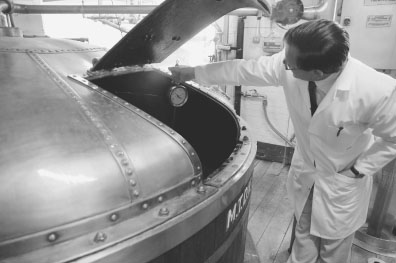Mash Tun is a brewhouse vessel used for mixing the ground malt (grist) with temperature-controlled water. This is called “mashing” and the porridge-like result is called the “mash.”

A brewer at Harveys Brewery in Sussex, England, takes a temperature reading in the mash tun. cath harries
The traditional mash tun is an enclosed circular vessel of varying diameter with a depth of about 2 m. They were constructed of steel or copper and were insulated on the vertical sides, which wereoften clad in wood. The floor of the mash tun has a series of removable plates which sit about 7 cm above the flat vessel floor. The plates have a series of slots approx 50 cm in length and 1 mm wide, which are about 10% of the vessel’s floor area. At a predetermined time after mashing, wort is washed from the mash tun by sparging, a rinsing process where hot brewing water, at approximately 75°C, is sprayed over the mash and the dissolved wort is run off from the bottom of the vessel.
In traditional breweries, the process of mashing, wort runoff, and emptying the mash tun takes about 6 h; in modern breweries two vessels are used to produce wort, a mash mixing vessel and a lauter tun, reducing this time to about 3 h. Because it requires less floor space and one fewer vessel, many small breweries in the UK and brewpubs in the United States continue to use the mash tun and its attendant mashing technique.
